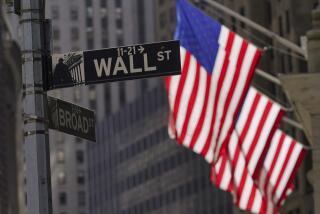U.S., Britain Answer Japan’s Plea to Boost Sagging Dollar : New York Federal Reserve, Bank of England Reported to Have Intervened in Foreign Exchange Trading Action
- Share via
TOKYO — The United States and Britain responded Tuesday to calls from Japanese leaders for joint intervention in foreign exchange markets to support the dollar after the American currency reached a new low in Tokyo.
Both the New York Federal Reserve Bank and the Bank of England were reported to have intervened in foreign exchange trading after the dollar fell in early trading to 148.35 Japanese yen in London and to 148.40 in New York. Interventions in both markets brought the dollar back up to close at 149.225 in London and 149 in New York.
Japan issued the calls after the dollar lost 1.3% of its value against the yen in Tokyo trading, plunging 1.93 points in $11.5 billion worth of trading, the heaviest in the history of the Tokyo Foreign Exchange, to close at a post-World War II record low of 148.80 yen. At one point, it sold for 148.40 yen, a record low for a single transaction.
Bank of Japan Intervention
(The dollar rebounded slightly on the Tokyo Foreign Exchange market today, opening at 149.60 yen, up 0.80 yen from Tuesday’s close.
“There were indications that the Bank of Japan intervened in the market soon after it opened” today to stop the yen’s rise, an official of a major Tokyo commercial bank told Associated Press.)
Citing a Feb. 22 meeting of the finance chiefs of the United States, Japan, Britain, France, West Germany and Canada in Paris, Finance Minister Kiichi Miyazawa said: “All of the countries already have consulted and reached agreement about the response to this kind of situation.”
Asked if he meant that the United States and other nations should carry out coordinated intervention in exchange markets, Miyazawa said, “Yes, that stage has been reached.”
“Japan cannot allow the yen to appreciate further,” said Miyazawa, who earlier had said the Feb. 22 agreement would stabilize the yen-dollar exchange rate at about 153 to $1.
Baker’s Statement Cited
Satoshi Sumita, governor of the central bank, also called for “close coordination with other advanced Western nations.”
Bank of Japan officials pointed to an agreement Jan. 21 between Miyazawa and Treasury Secretary James A. Baker III, the precursor of the Feb. 22 accord, to stabilize exchange rates. Miyazawa had flown to Washington to appeal for U.S. support in halting the fall of the dollar after the U.S. currency plunged to its previous record low of 149.98 yen on Jan. 19.
Some traders here attributed the plunge in the dollar’s value in Tokyo on Tuesday to a statement by Baker on a London television program Monday that no agreement had been reached Feb. 22 on a target zone of the dollar’s value, contrary to Miyazawa’s statements and the market’s belief.
Other financial market experts blamed the plunge on Japan’s tardiness in carrying out promises that Miyazawa made to Baker on Jan. 21 and to the other financial leaders Feb. 22 to adopt new policies promoting domestic growth and inducing more imports in exchange for cooperation in stabilizing exchange rates.
A steep 18-month appreciation of the yen, which reached 62.6% with Tuesday’s trading in Tokyo, drove down the amount of yen that Japanese exporters received for their products in 1986 by 6.7 trillion yen--$45 billion at Tuesday’s exchange rate--compared to 1985 yen earnings from exports.
The plunge held down real growth in Japan to 2.5% last year, the lowest in 12 years, and drove unemployment up to a record 3% in January.
Declaring that the new spurt in the yen’s value threatens to “plunge Japanese industry into a dire situation,” Hajime Tamura, minister of international trade and industry, urged the government to speed up adoption of policies to promote domestic growth.
More to Read
Sign up for Essential California
The most important California stories and recommendations in your inbox every morning.
You may occasionally receive promotional content from the Los Angeles Times.













